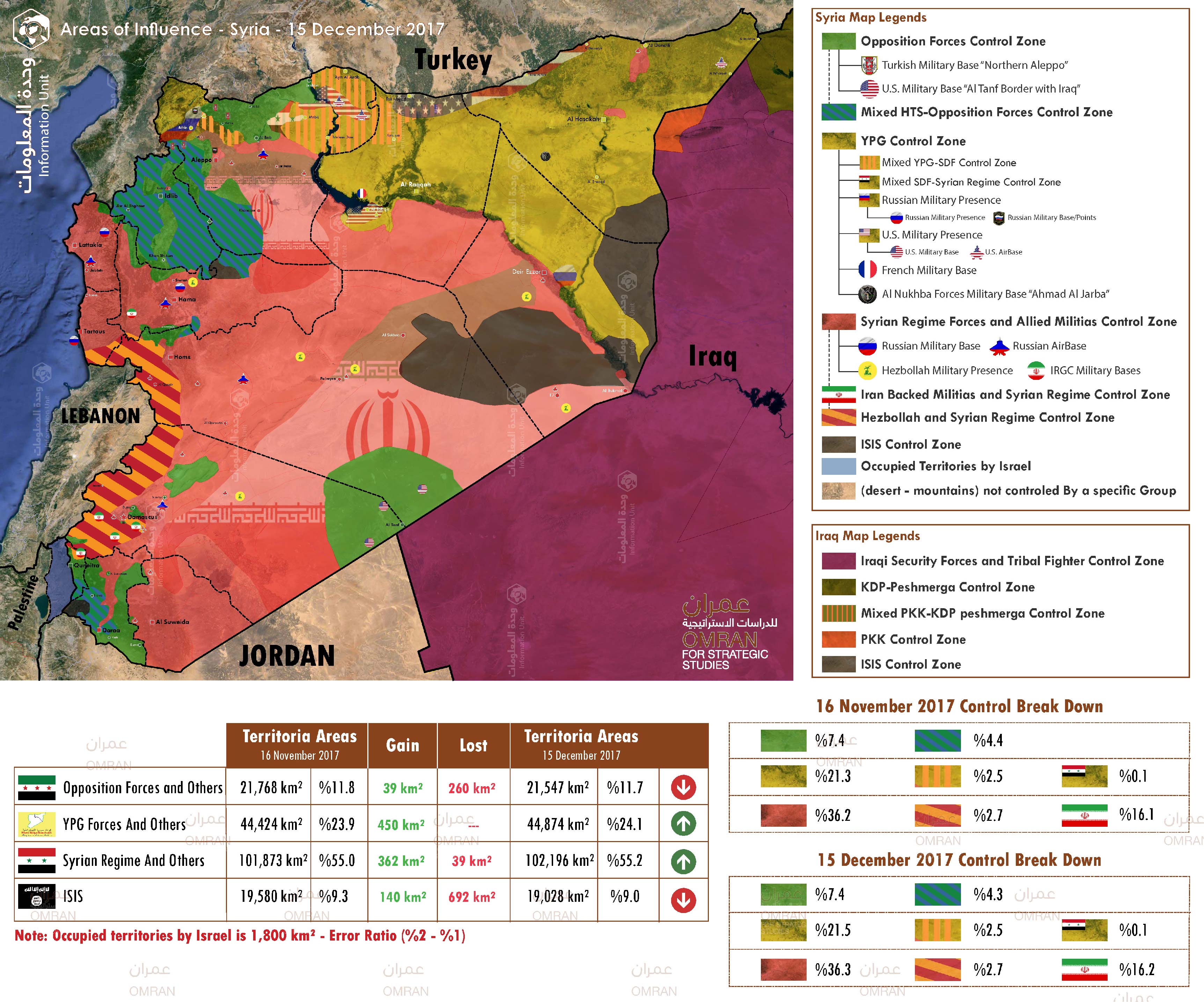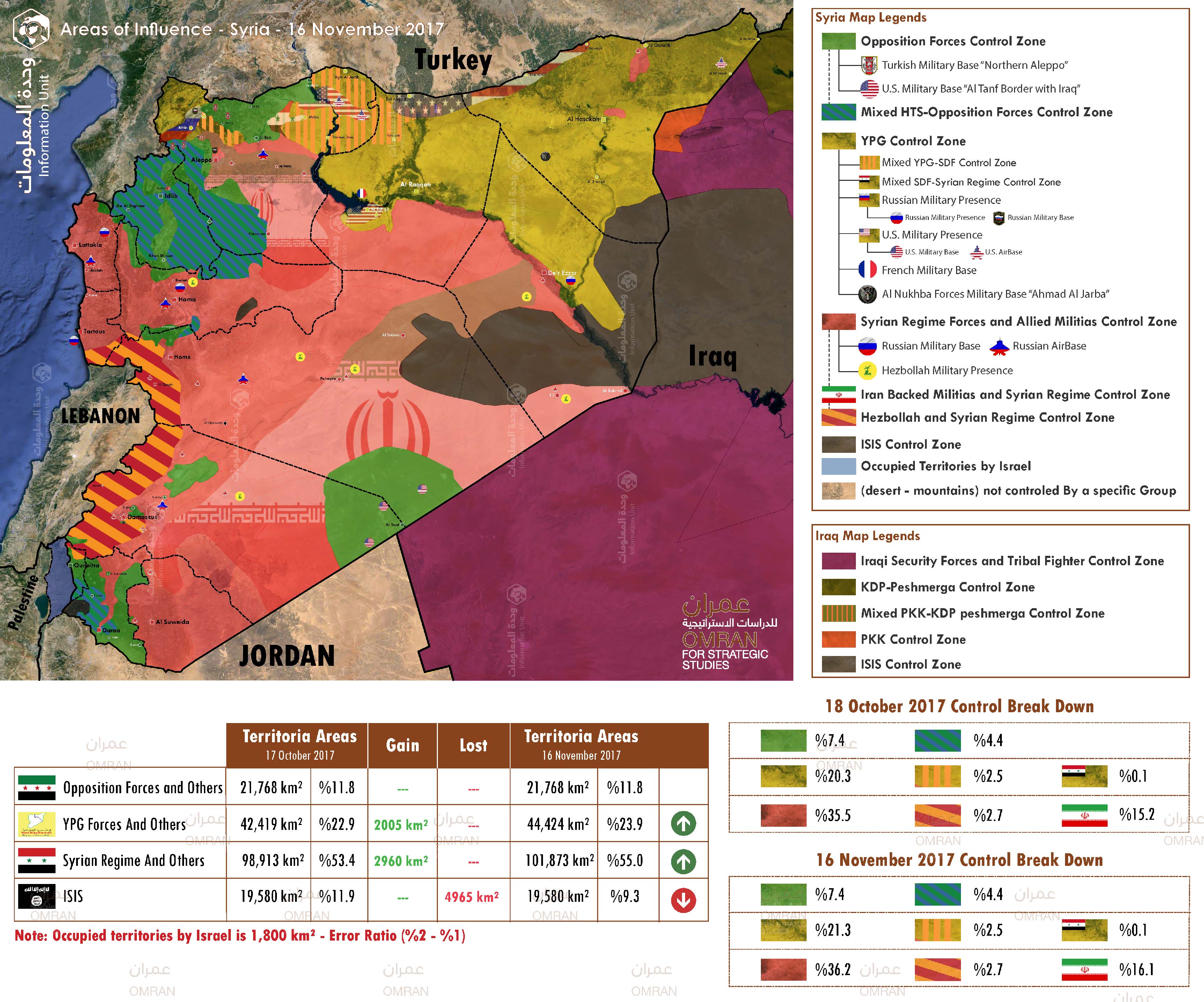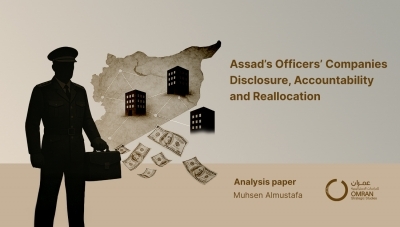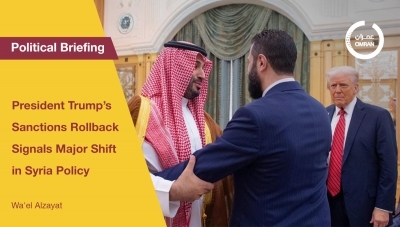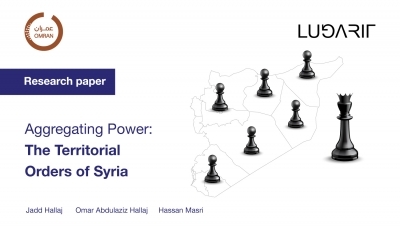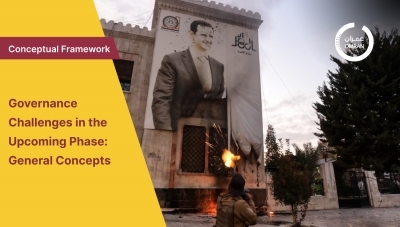Events
Map of Control and Influence: "Syria 15 December 2017"
Damascus
- December 7, inside sources, reported that Hay’at Tahrir Al-Sham-affiliated combatants who were not pre-war inhabitants of Eastern Ghouta will be evacuated to Idleb governorate in the coming weeks. This development is pursuant to an agreement reached between armed opposition groups in the area and the Government of Russia.
- December 8, media sources indicated that representatives from the Syrian Regime have reached an agreement on the terms of a reconciliation agreement with the Negotiation Committee of Raheiba, in Raheiba subdistrict, in the eastern Qalamoun region of Rural Damascus governorate.
Important Note The most important terms reportedly included: implementation of a ceasefire in exchange for the entry of basic humanitarian aid and water; the establishment of a Syrian Regime local governance structure and the dissolution of all local opposition administrative structures.
- December 10, media sources claimed several ISIS commanders have evacuated Yarmouk camp and Hajar Aswad over the past month. Unconfirmed reports indicate they have relocated to ISIS-affiliated Jaish Khaled Ibn Al-Waleed-controlled areas of southern Syria.
- December 12, Clashes have continued in the vicinity of Bait Jan, in Bait Jan subdistrict in Western Ghouta, between opposition forces and Syrian Regime backed by Pro-Iran Militias. At present, advances by both parties remain tentative.
Important Note The humanitarian situation in Eastern Ghouta continues to deteriorate. Bread pack prices reached 1,900 SP, 1kg of rice is currently at 4,000 SP, and most day-to-day essentials are scarce in public markets.
Southern Front
- December 7, Hezbollah and Pro-Iran militias have reportedly deployed reinforcements to Jidya and Deir Eladas, located west and north of As-Sanamayn in Northern Daraa.
Al Hasakeh
- December 8, media reports claimed the U.S.-led international coalition sent a sizeable weapons shipment to the Syrian Democratic Forces (SDF). This shipment reportedly entered Al-Hasakeh governorate through the Syria—Iraq Fishkabour border crossing.
Important Note Last weapons shipment to enter the area was reportedly delivered on November 23, on November 24, President Trump reportedly informed President Erdogan that the U.S. intended to end its support to the SDF in Syria.
- December 12, humanitarian conditions in Shaddadah camp have continued to deteriorate. Of note, Shadadah camp is located between Al-Hasakeh city and Shadadah town. Reports indicate the total number of IDPs in the camp is now at least 6000 individuals, 90% of which were displaced from Deir Ez-Zor governorate on account of ongoing military operations.
Important Note The camp’s inhabitants reportedly suffer from a lack of basic food items, especially bread, as well as limited WASH and medical support. Unconfirmed reports indicate that around 150-200 people have been evacuated to Damascus each week since the start of December for medical treatment. Generally speaking, IDPs in Al-Hasakeh governorate continue to experience difficult conditions, especially given the limited capacity of existing camps to host all those displaced from Deir Ez-Zor governorate as well as worsening seasonal weather conditions.
Aleppo
- December 6, inside sources, indicated that airstrikes targeted Al-Azzan mountain, located 19 km south of Aleppo in the vicinity of Azzan town, Jebel Saman subdistrict. According to these sources, the attacks were launched by the Government of Israel and targeted an Iranian backed militia (Badr Organization) military base established in 2015.
Important Note December 1 and 4, Israeli airstrikes also targeted Government of Syria-controlled munitions storage facilities located between Kisweh and Sahnaya, south of Damascus city, and in Jamraya, in Qudsiya subdistrict.
- December 9, the Syrian Interim Government issued a statement claiming to have held a meeting with 37 opposition forces representatives in northern rural Aleppo, which concluded with an agreement to establish a ‘National Army’.
Idlib
- December 10, the Salvation Government issued a statement in which it announced the Syrian Interim Government would have 72 hours to evacuate all of its offices in Idlib governorate.
Important Note this comes after a statement on December 9, in which the Syrian Interim Government’s Head of Public Relations was cited as having described the Salvation Government as a terrorist organization.
Map of Control and Influence: Syria "16 November 2017"
Damascus
- November 11, unconfirmed reports indicated that Jaish Al-Islam and the Government of Russia reached an agreement stipulating Jaish Al-Islam’s future role as the sole military and political actor in Eastern Ghouta.
- November 12, a UN inter-agency convoy entered Duma city, Duma subdistrict, through Al-Wafideen crossing in coordination with SARC and the ICRC.
- November 15, Ahrar al-Sham launched an attack on the regime forces stationed in the management of vehicles in Harasta, the attack came in response to the regime's repeated attacks on Eastern Ghouta.
Important Note:The humanitarian situation in Eastern Ghouta continues to deteriorate. Bread pack prices reached 1,900 SP, 1kg of rice is currently at 4,000 SP, and most day-to-day essentials are scarce in public markets.
Southern Front
- November 12, Unconfirmed reports suggest the Jordan-based Military Operation Center (MOC) has disbursed its last payment to Southern Front Alliance combatants, as well as its final arms and munitions delivery.
Al Hasakeh
- November 9, SDF established full control over Markada city, in Markada subdistrict, Al Hasakeh governorate.
Important NoteMarkada was considered as the last major city controlled by ISIS in the governorate. Moreover, SDF control over Markada secures its control over the eastern bank of Euphrates River in southern Deir Ez Zor, as well as oil and gas in the area. Nevertheless, reprisal attacks by ISIS combatants remain possible.
- November 12, YPG-led Syrian Democratic Forces (SDF) reportedly handed 52 Russian Chechen individuals, thought to be families of ISIS combatants, to the Government of Russia.
Aleppo
- November 12, Clashes and shelling continued in western rural Aleppo governorate between Noureddine Zinki, a prominent armed group in northern Idlib and northwestern Aleppo, and Hayat Tahrir Al Sham (HTS).
Important Note Clashes reportedly ensued after Hay’at Tahrir Al-Sham attempted to prevent combatants who defected from Hay’at Tahrir Al-Sham from joining Noureddine Zinki in Hayyan and Andan, in Haritan subdistrict, which is controlled by both groups. During the clashes.
- November 13, Syria Regime and aligned forces, allegedly to include Russia, carried out airstrikes on Atareb city, Atareb subdistrict in northwestern Aleppo governorate. Various media sources and local sources have reported casualties at approximately 70 individuals, while several sources reported that at least one airstrike targeted a market in central Atareb city as well as a police station.
Deir Ez Zor/Al Raqqa
- November 8, Syria Regime and Pro-Iran Militias reportedly took control of the Abukamal border crossing, located on the Syria-Iraq border in southeastern Deir Ez Zor governorate.
Important Note as of November 5, Hashd Sha’bi, an Iraqi Hashd Sha’bi militia, took control over Al-Qaim town and its nearby border crossing, opposite Abukamal along the Iraqi-Syria border.
- November 11, SDF reportedly controlled Basira, in Basira subdistrict, and its vicinity, located approximately 32 km south of Deir Ez Zor city.
Important Note 69,047 individuals have been displaced from Abukamal subdistrict to SDF-controlled areas in northern and eastern Syria due to clashes between Syrian Regime forces and ISIS.
Battle of Deir ez-Zor & Raqqah September & October 2017
- October 9, Syrian Democratic Forces reportedly continued their advance in the eastern Deir-Ez-Zor governorate, capturing Mweileh town in Sur subdistrict, located north of Sur city.
- October 10, Syrian Regime offensive is largely dependent on Russian aerial coverage; the Russian Foreign Ministry announced that 150 daily Russian airstrikes had targeted ISIS bases in Mayadin city.
- October 15, SDF spokesperson announced that all willing combatants have evacuated the city; however, the likely destination of potential ISIS-affiliated evacuees is currently unknown. Furthermore, the SDF-led ‘Wrath of Euphrates’ operation against ISIS has led to SDF control over most neighborhoods in Ar-Raqqa city amidst heavy aerial support by the U.S.-led coalition, resulting in a high rate of civilian displacement.
- October 15, Syrian Regime forces and Allied Militias, supported by Russian aerial and ground forces, continued their advance south of Deir-Ez-Zor city, Syrian Regime forces, advanced into Al Mayadin city, Al Mayadin subdistrict, located 43.8 km south of Deir-Ez-Zor city.
- October 17, About 400 Islamic State (ISIS) members, including foreign fighters, have in recent weeks surrendered to U.S. backed forces in ISIS former Syrian stronghold Raqqa; inside source confirmed that the ISIS Syrian fighters were transferred to "Ayn Issa" Camp, while the foreign fighters were transferred to "Suluk" Military headquarter.
- October 18, Syrian Democratic Forces reportedly captured the several villages from ISIS, 7 KM eastern side of Deir-Ez-Zor City.
Important Note: As of the end of September, nearly 708,000 individuals are reported to still remain in ISIS-held communities in Deir-Ez-Zor governorate. This includes approximately 120,000 individuals in ISIS-held northern Deir-Ez-Zor governorate between Tabni, Tabni subdistrict, Deir-Ez-Zor City and the Euphrates River; 68,000 individuals in the ISIS-controlled western Deir-Ez-Zor governorate from Khasham in Khasham subdistrict to Markada across Khabour River; 120,000 in southern Deir-Ez-Zor governorate from Hajin to Abukamal; and nearly 400,000 individuals in the central Deir-Ez-Zor governorate.
Strait Talk: Panel discussion with Yaser Tabbara and Sinan Hatahet on the latest in Raqqa
Mr. Yaser Tabbara board member of the Omran Center for Strategic Studies. And by Sinan Hatahet answered several important question in regard of Raqqah operation and what is the current condition after U.S. and their ground Allies "PYD" took control of the city from "ISIS". Mr. Yaser talked about the current relationship between the U.S. and "PYD" specially after raising "Ocalan" picture in the city by some "PYD" fighters. Mr. Yaser also talked about the Syrian Regime reaction on "PYD" taking control of the City, and what are the possible scenarios for the Regime in regard of Raqqah
Mapping the Battle Against ISIS in Deir Ezzor
In recent weeks, the so-called Islamic State has suffered a string of defeats in eastern Syria. It has lost swaths of territory in Deir Ezzor city to advancing pro-Syrian government forces and has been driven from villages and oil fields on the eastern banks of the Euphrates River by a U.S.-backed paramilitary group.
The two simultaneous but separate offensives by the Syrian Democratic Forces (SDF) and Syrian government loyalists may have resulted in quick gains in their first few weeks, but fighting is ongoing in many parts of the province, much of which remains under complete militant control.
ISIS still controls roughly 74 percent of the Deir Ezzor province and commands two main strongholds in the areas of Boukamal and Mayadin, south of the provincial capital. The group also controls a resource-rich region east of the Euphrates River that contains most of the oil and gas fields in the province.
With a long and grueling campaign still underway to expel the militant group from its last bastion in Syria, Syria Deeply examines the battle for Deir Ezzor by looking at the main groups, their objectives and their advances in the region.
Who Is Fighting in Deir Ezzor
Syrian government loyalists are the main fighting force in Deir Ezzor city and the surrounding countryside. Their forces consist of two specialized Syrian army divisions: the Republican Guard and the 17th Reserve Division, which is responsible for northern and eastern Syria.
A number of pro-government militias are assisting, including the Baath Battalions, a Syrian paramilitary group that fought rebels in Aleppo province last year. The Galilee Forces (a Palestinian militia), the National Defense Forces(one of the largest pro-government militias operating in Syria), and the Syrian al-Qassam group’s elite forces.
The Lebanese Hezbollah and a number of other Iran-backed groups are also fighting alongside the Syrian army in Deir Ezzor, as are a number of local tribes, most notably the al-Shaitat tribe. Russian warplanes are providing aerial cover for pro-government advances, and Moscow announced on Thursday that it has deployed special forces to assist the Syrian army.
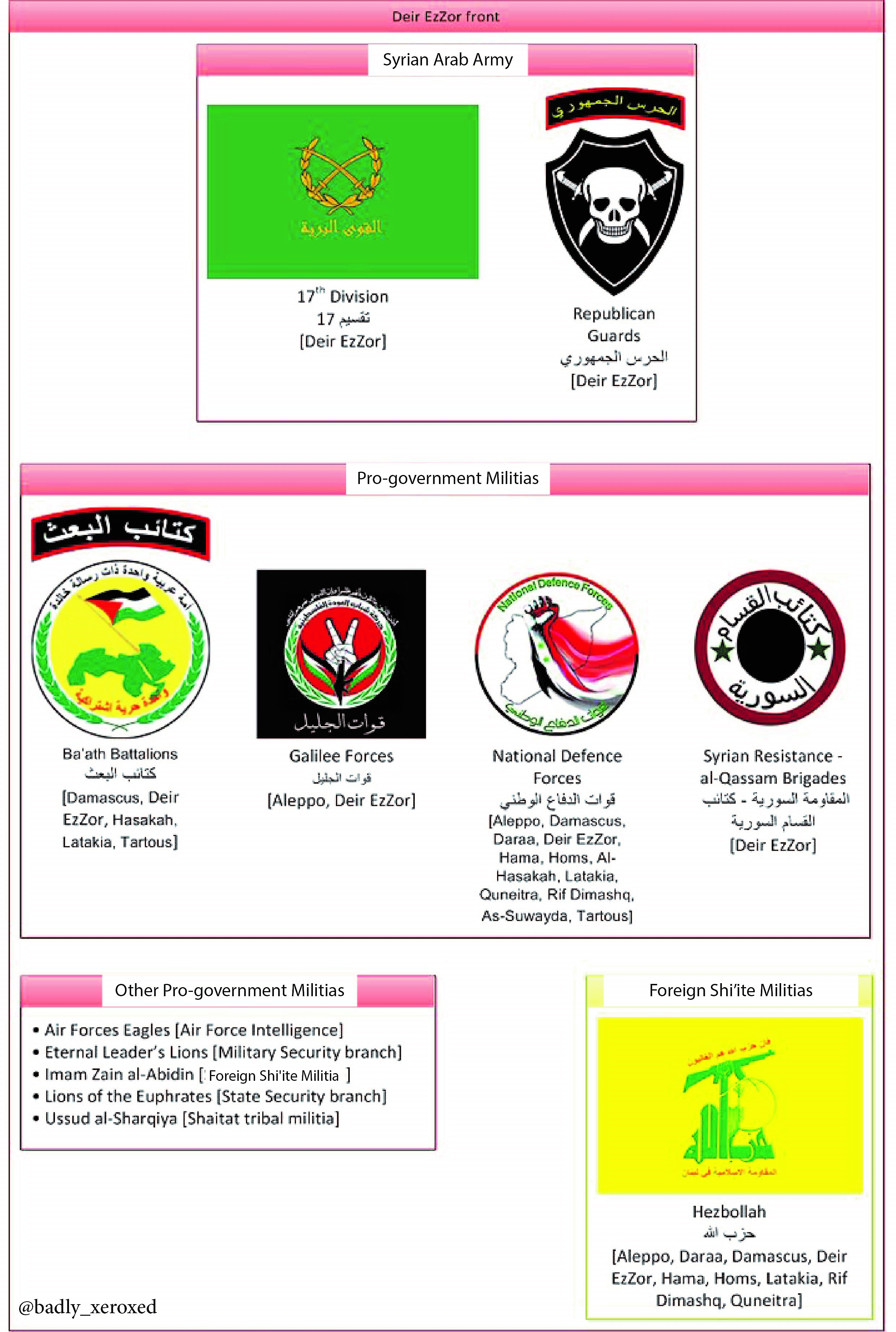
Infographic breaking down the multiple groups fighting alongside the Syrian army in Deir Ezzor. (Nawar Oliver)
On the eastern banks of the Euphrates River, a contingent of the U.S.-backed Syrian Democratic Forces, known as the Deir Ezzor military council, is also fighting ISIS. It is supported by U.S.-led coalition warplanes and U.S. special forces embedded within its ranks. The Deir Ezzor military council is made up mostly of Arab fighters from Deir Ezzor, but is supported by Kurdish fighters of the SDF.
The Race for Deir Ezzor
Although the SDF and the Syrian government have framed their respective operations in Deir Ezzor as primarily a battle against ISIS, each side has other objectives.
For the Syrian government, recapturing Deir Ezzor has been a main priority since the start of 2017, and gaining complete control over Deir Ezzor city, the largest city in eastern Syria, would be a symbolic victory.
Control over the oil-rich region on the southeastern flanks of Deir Ezzor province would also secure key natural resource revenues for the Syrian government.
The province is located along part of Syria’s border with Iraq, so controlling the area would help the government reassert its authority over the quasi-totality of its frontier with its southeastern neighbor. Increased government influence in Deir Ezzor would also help Iran secure a land bridge between Iraq and Syria, especially via the city of Mayadin, which provides a land route from Damascus to Iraq.
The government’s push in Deir Ezzor is also aimed at preventing a Raqqa scenario. In other words, the Syrian government is trying to keep U.S.-backed forces in Syria from carving out a zone of influence in the eastern province after ISIS withdraws.
For the SDF and its primary backer, Washington, the battle for Deir Ezzor is largely posturing against Assad’s forces. The group announced its operation in Deir Ezzor only days after pro-government forces breached ISIS’ siege on parts of the city, signaling to the government that its advance in the province would not go uncontested.
Although the SDF has said it would not enter Deir Ezzor city and would leave the area to pro-government forces, the group is seeking to expand its influence in the oil-rich parts of the province on the eastern banks of the Euphrates and in ISIS strongholds near the border with Iraq. This push is driven by Washington’s aim to secure the Iraqi border and prevent Iran from gaining a foothold in the region.
Tracing Government Advances
In recent weeks, pro-government forces have pushed into Deir Ezzor city from the west, along the al-Sukhna-Deir Ezzor highway, and achieved significant territorial victories in the provincial capital and its countryside. They have pushed ISIS militants back from areas around a military garrison known as Brigade 137, have breached a three-year siege of Deir Ezzor’s military airbase and a number of adjacent neighborhoods, and have also secured the strategic Deir Ezzor-Damascus highway.
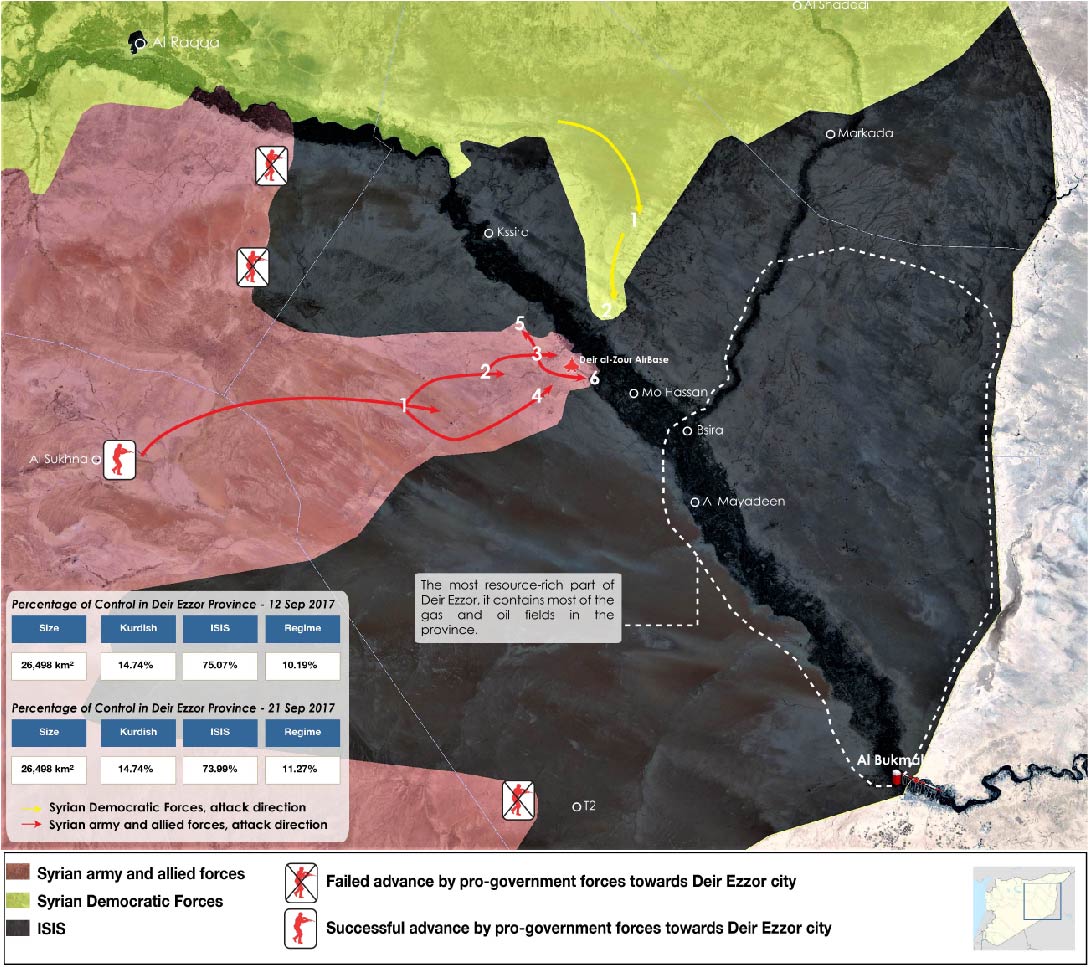
Map of control for Deir Ezzor province that also shows advances by pro-government forces and the SDF. (Nawar Oliver)
The Syrian army said over the weekend that its forces have captured at least 44 villages and towns since launching the assault on Deir Ezzor earlier this month. According to the Syria Observatory for Human Rights (SOHR), pro-government forces control roughly 64.3 percent of the provincial capital, while ISIS militants control 35.7 percent. Russia’s Defense Ministry, however, said last week that pro-government forces are in control of at least 85 percent.
They have also made significant gains on the western banks of the Euphrates, in Deir Ezzor’s northwestern countryside, where they have captured more than 60 miles (100km) of former ISIS territory, the SOHR said last week.
Pro-government forces also crossed into the eastern bank of the Euphrates last week, reaching within 3 miles (5km) of SDF-held positions.
The government’s advance suggests three short-term objectives. By expanding control on the western and eastern banks of the Euphrates, the Syrian government is trying to seal the eastern and western gateways to the city, thereby besieging ISIS in a pocket in the provincial capital.
It is also trying to complicate SDF advances in the region by preventing the group from reaching ISIS positions on the western axis while also blocking any potential SDF push down the east bank of the Euphrates.
The advance on the eastern banks of the Euphrates is also driven by an attempt to secure oil and gas fields in the area, most notably the al-Omar oil field, Syria’s largest and most lucrative field.
Current advances, however, do not signal an imminent push south toward ISIS strongholds in Boukamal and Mayadin. It would appear then that the real battle in ISIS’ best-fortified stronghold is delayed.
Tracing SDF Advances
Over the past two weeks, the SDF has pushed into Deir Ezzor province from the northeast using the Hassakeh-Deir Ezzor Highway, gaining full control of Deir Ezzor’s industrial zone and capturing a major gas field in the area.
The Conoco gas plant, Syria’s largest, came under full SDF control on Saturday, after days of fighting ISIS militants in the area. The plant had the largest capacity of any in Syria prior to the conflict, producing up to 459 million cubic feet (13 million cubic meters) of natural gas a day.
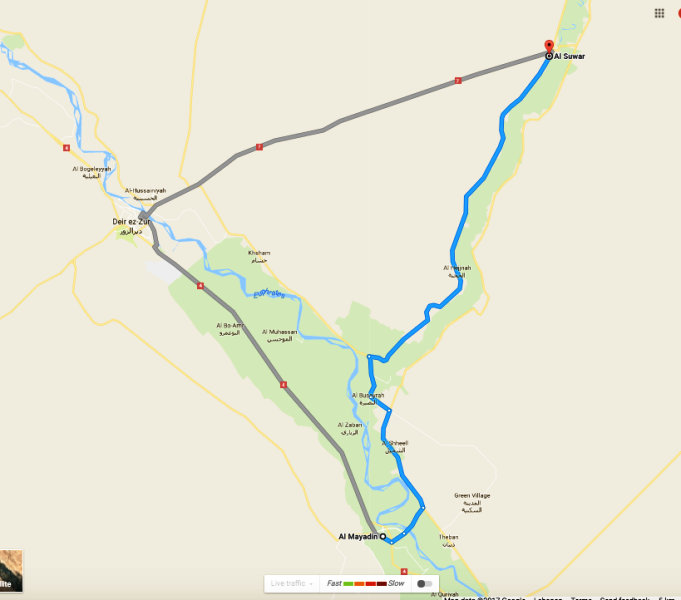
SDF forces are now moving away from Deir Ezzor city and advancing toward the Iraqi border. On Sunday, the push to capture the town of al-Suwar began, according to the SOHR. The area is a strategic junction which provides land and supply routes connecting SDF positions to ISIS strongholds in Boukamal and Mayadin. A coalition spokesman said over the weekend that these two ISIS strongholds, some 50 miles (80km) west of the Iraqi border, are the SDF’s eventual goal.
Risk of Confrontation
The race for gas and oil fields in the eastern banks of the Euphrates has increased tensions between Russia, the U.S. and their respective allies over resource-rich parts of Deir Ezzor.
The SDF said on Monday that Russian warplanes bombed their positions in the Conoco gas field, killing one SDF fighter and wounding two others, just two days after the U.S.-backed forces captured the area.
That same day Moscow blamed U.S. policy in Syria for the death of Russian Lt. Gen. Valery Asapov in ISIS shelling near Deir Ezzor one day earlier.
“The death of the Russian commander is the price, the bloody price, for two-faced American policy in Syria,” Russian deputy foreign minister Sergei Ryabkov said. “The American side declares that it is interested in the elimination of [ISIS] … but some of its actions show it is doing the opposite and that some political and geopolitical goals are more important for Washington.”
This is not the first time that the two sides have traded jabs over attacks in east Syria. Earlier this month, the SDF and the Pentagon accused Russia of shelling an SDF position in Deir Ezzor’s industrial zone. Last week, Russia said that it would target SDF positions in east Syria if pro-government forces come under fire from the group.
Moscow’s warning came after Russia accused the SDF of opening fire on Syrian troops and allied forces on the eastern bank of the Euphrates twice last week. Moscow has also accused the SDF of hindering government advances in the area by opening upstream dams to prevent its allies from crossing.
In an attempt to prevent an outbreak of clashes, U.S. and Russian generals held a face-to-face meeting to discuss operations in Deir Ezzor last week.
“The discussions emphasized the need to share operational graphics and locations to ensure … prevention of accidental targeting or other possible frictions that would distract from the defeat of ISIS,” Col. Ryan Dillon said.
Monday’s attack undermines earlier talks and signals that the U.S. and Russia have yet to reach an agreement over the oil-rich zone coveted by all sides. With Monday’s attacks, it would seem that oil-rich areas east of the Euphrates will serve as a testing ground for U.S. and Russian de-confliction arrangements.
If the two sides fail to delineate areas of respective control then sporadic fighting will continue to obstruct the campaign against ISIS in the area and will leave both sides vulnerable to militant counterattacks.
Published In The Syria Deeply, 26 Sep. 2017,
Written byHashem Osseiran, Nawar Oliver
ISIS and the Strategic Vacuum- The Dilemma of Role Distribution- The Raqqa Model
Executive Summary
- The Raqqa operation closely mirrors the Mosul operation both politically and militarily. Politically, it was launched amid disagreements and a lack of clarity about which local and international forces would participate and who would govern the city post liberation. Militarily, ISIS used the same strategy it used in Mosul aiming to exhaust the attacking forces with the use of improvised explosive devices instead of direct combat. ISIS also retreated from positions near the borders of Raqqa and took more fortified positions inside neighborhoods with narrow streets in an attempt to change the battle into an urban combat nature.
- The battle uncovered critical weaknesses in the Syrian Democratic Forces (SDF) and its ability to fight alone. The SDF required heavy cover fire from Coalition forces as well as direct involvement of American and French forces, which deployed paratroopers in the area and changed the course of the battle by taking control of the Euphrates Dam and Tabqa Military Airport.
- The tense political environment and the various interests of regional and international players will significantly impact the battle for Raqqa and future battles against ISIS in Syria.
- This paper projects four scenarios about how the Raqqa operation and future operations could play out.
- First, the United States’ continued dependence on YPG-dominated SDF forces as its sole partner, which will exacerbate tensions with Turkey.
- Second, a new agreement or arrangement between Turkey and the U.S.
- Third, a new arrangement between Russia and the U.S. in Raqqa, similar to what took place in Manbij.([1])
- Fourth, the latest Astana agreement, which could set the groundwork for the U.S. to open the way for all Astana parties to participate in the Raqqa battle.
- The most important contribution of the U.S. in Syria was undermining the “post-Aleppo status quo”([2]) established by Russia in an attempt to create an environment more consistent with an American policy that is more involved in the Middle East, especially in Syria.
Introduction
On May 18, 2016, the Syrian Democratic Forces (SDF), of which the predominately Kurdish People’s Protection Units (YPG or PYD) form the main fighting force, launched an operation with a few American and French Special Forces and International Coalition air support to take Raqqa from ISIS control. According to the SDF, the battle ended on May 31, 2016, due to fierce resistance by ISIS fighters and the widespread use of mines in the rural areas surrounding Raqqa. At that time, the battle for Manbij was announced. The SDF seized control of Manbij on August 12, 2016, after which the battle for Raqqa was relaunched. In its first three phases, the battle for Raqqa achieved its desired goals: cutting off supply routes and lines of communication between ISIS’s Iraqi and Syrian branches, isolating and besieging Raqqa, and finally preparing for the offensive attack on besieged Raqqa, which is the fourth and final phase of the current operation.
The Raqqa operation closely mirrors the Mosul operation both politically and militarily. Politically, it was launched amid disagreements and a lack of clarity about which local and international forces will participate and who will govern the city post liberation. Militarily, ISIS used the same strategy it used in Mosul aiming to exhaust the attacking forces with the use of improvised explosive devices instead of direct combat. ISIS also retreated from positions near the borders of Raqqa and took more fortified positions inside neighborhoods with narrow streets in an attempt to change the battle into an urban combat nature. Furthermore, the battle uncovered critical weaknesses in the SDF’s ability to carry out the fight alone. The SDF required heavy air support from Coalition forces, as well as direct involvement of American and French forces, which deployed paratroopers in the area and changed the course of the battle by taking control of the Euphrates Dam and Tabqa Military Airport.
This paper analyzes the various political contexts surrounding the battle for Raqqa and breaks down the interests of the local and international actors involved. Furthermore, this paper projects scenarios about the governance of Raqqa post liberation, which is expected to have a significant impact on a political settlement and the future Syrian state.
Political Climate Preceding the Battle
The U.S.-led International Coalition decided to launch the battle for Raqqa depending solely on the SDF. Other groups that had previously been excluded from operations in Syria—until now—rejected the Coalition’s decision. However, similar to the way the US led international coalition initiated the operation in Mosul, their decision reflected two things: 1) the Coalition’s need to open a battle front in Syria in support of the Mosul operations, and 2) the desire for the operation to focus on fighting ISIS without allowing any participating party to exploit the battle for its own interests. Therefore, it seems that America’s choice of the YPG as the main fighting force of the SDF in Syria secured American interests, particularly by enabling Kurdish forces to participate, and created more obstacles for Turkey and Russia, whose participation in the battle remains a sore point. The battle for Raqqa is yet to begin, but the circumstances, as they are, force Turkey and Russia to align their interests more closely with America’s in the fight against ISIS if they want to participate in the fight—and in shaping the future Syrian state.
Interestingly, the dilemma of choosing partners and distributing roles is more difficult for the U.S. in the battle for Raqqa than it was in the battle for Mosul due to a number of political and military factors that make Syria different from Iraq.
A. Military Factors
The battle for Raqqa will be one of the toughest for the International Coalition because ISIS has lost significant territory in Iraq and thus will put more effort into maintaining the major cities it still controls in Syria, such as Raqqa. Furthermore, the SDF’s role in the first phases of the operation to surround Raqqa revealed that the group is not capable of carrying out the fight against ISIS in Syria on its own. This is especially concerning due to the SDF’s large numbers, with some sources estimating around 30,000 fighters. Even if we accept this inflated estimate, 30,000 fighters is significantly smaller than the force of 120,000 that is participating in the battle for Mosul, which is yet to be completed. Considering these factors, it is questionable as to how a 30,000-person force could take on ISIS in Syria.
Major SDF Battles with ISIS 2016 - 2017
Measure of Level of Participation from 1 – 10

Table No. 1 Source: Monitoring Unit at Omran Center for Strategic Studies
B. Political Factors
Regional and international political interests are more aligned in Syria than they are in Iraq; however, participation of local actors is much less in Syria than in Iraq. Additionally, the government of Iraq maintains a national military, international legitimacy, and a reasonable level of national sovereignty to a much greater extent than the Assad-led government in Syria. Furthermore, the Kurdistan Regional Government in Iraq is a successful political project that poses little threat to other Iraqi forces. The PYD in Syria, however, is a militia that has its own political project and thus poses a threat. Furthermore, the number of international and regional actors in Iraq is far fewer than that in Syria. In Iraq, competition between international and regional actors is limited to the framework of a crisis between Turkey and Iran, and the Russian-American row is almost nonexistent; however, these complications are amplified in Syria.
The factors described above and the various interests of regional and international actors will significantly impact the battle for Raqqa and future battles against ISIS in Syria. This was clearly reflected in the reactions of various players to the announcement of the battle for Raqqa as described below.
1. Turkey - Drawing the line at National Security
For Turkey, the YPG participation in the battle for Raqqa is a red line for its national security. For this reason, Turkey’s president and other officials responded strongly to the announcement of the start of the battle, at one point threatening to close Incirlik Air Base, especially if the International Coalition were to insist that the SDF, of which the YPG makes up the bulk of the forces, leads the battle.([3]) There was also a negative atmosphere left behind due to the U.S. and the Coalition’s lack of support for Turkey’s Operation Euphrates Shield. Instead, Turkey relied on opposition forces, coordinated with Russia, and received minimal assistance from the U.S. These events revealed Turkey’s ability to launch an operation towards Raqqa with Syrian opposition forces without coordinating with the U.S. or the Coalition. Instead, Turkey could coordinate with Russia to prevent the SDF from expanding and taking over more Syrian territory. This is more likely due to statements made by Ankara that indicate its willingness to start new operations in Syria to liberate Raqqa. ([4])
Turkey also announced that it was supporting forces known as the Eastern Shield, made up of groups from eastern Syria currently operating in northern rural Aleppo.([5]) Turkey’s desire to act alone was expected after Washington ignored the Turkish proposals([6]) and after a March 7 meeting in Antalya, Turkey, about who would participate in the battle for Raqqa produced no results. So far, Washington’s position on YPG participation in the battle for Raqqa has proven to be a strong test for its relations with Ankara. Many Turkish officials have stated clearly that Washington’s insistence on the YPG’s participation in the battle will jeopardize relations between the two countries.([7])
2. Russia - Stuck in the Middle
Russia views U.S. involvement in the fight against ISIS and the increased number of American troops in Syria as a threat to its political prowess and its control of the military situation on the ground. This was especially the case during the Obama administration. In fact, launching the battle for Raqqa without coordinating with Moscow, coupled with the U.S.’s refusal to allow regime forces or Iranian-backed militias to participate, which meant Moscow would not be included either. This led Russian officials to make a number of statements demanding to participate in the operations. Moscow indicated its desire to coordinate with the SDF and the International Coalition in the fight to take Raqqa, even after the American strikes on the Sheirat Airbase and after Russia announced its cancellation of military cooperation with the U.S. in Syria. The Russian Foreign Minister Sergey Lavrov sent conciliatory messages to the Americans regarding the battle for Raqqa hoping to unite efforts between Russia and the International Coalition in fighting terrorism in Syria.([8]) The U.S. continues to reject Russian attempts to legitimize the Assad regime in the battle of Raqqa. Instead, America has conditioned any Russian role in Raqqa on reaching an understanding about a political solution in Syria that addresses Bashar al Assad’s future role in Syria. Until now, this remains a difficult task to achieve.
Russia is dealing with this American predicament surrounding the battle for Raqqa and must make a decision on who its allies will be. There are possibly two options: either give up its alliance with Iran and Assad and move closer to the U.S. or continue with its Assad/Iran alliance. If Russia chooses the second option, then it will lose any opportunity to be a partner in any internationally endorsed solution. Instead, Russia will be considered part of the problem. At the same time, Moscow is trying its best to create a third option by playing on the disagreement between Turkey and the U.S. regarding the role of the Kurdish militia in the battle for Raqqa. This Russian plan may be the one that appeals to all parties, similar to what happened in Manbij.([9]) The plan aims to encourage the U.S. to coordinate with Russia in the battle for Raqqa by allowing Assad regime forces to be included in the operations. Assad’s forces will enter into certain areas forming a buffer between the SDF and Turkish-backed forces with American and Russian oversight. This plan does not require undoing any existing agreements made after the fall of Aleppo, especially between Russia and Turkey. Turkey is not completely disturbed by the regime’s military activities in northern Syria since the placement of regime forces effectively separates the Kurdish cantons—Qamishli, Ain al Arab, Kobani (east of the Euphrates River), and Afrin (west of the river). This is exactly what Ankara wants.([10]) This would also ensure that Turkish-U.S. relations are not negatively impacted due to the less problematic Kurdish issue, if such a plan succeeds.([11])
3. Iran - Weary of All Parties
Iran rejected the new American presence in Syria. Iran also denied reports that the American incursion into Syria occurred based on an agreement between the two.([12]) Coming from Ali Larijani, chairman of the Parliament of Iran, this position reflected Iran’s fears of not only being excluded from the fight against terror but also a wholesale change in policy against the country, especially by the Trump administration. Trump considers Iran to be the main sponsor of terrorism in the region and considers its official forces and the militias it supports to be in the same camp as the terror groups in Syria. These are critical strategic challenges facing Iran that could change its future role in the region. Iran will specifically find it difficult to manage issues where its interests are in competition with the policies of the new American administration—in Iraq, where Baghdad is cozying up to Washington on the back of the Mosul operations, coupled with the increased American presence in Iraq and Syria, where America has deployed Marines in the North.([13])
Iran is also skeptical of Russia’s regional activities, such as its closer relations with Turkey. Furthermore, Iran is concerned by Turkey sending military forces into northern Syria, which weakens Iran’s ability to expand. Iran is also troubled by Russia’s willingness to sell out Iran and its militias in an American-Russian deal that would protect Russia’s interests. This is especially true after Israel stepped in to pressure both Moscow and Washington to put an end to the presence of Iranian-backed militias in Syria.
4. Syrian Democratic Forces (SDF) - Avoiding the Cracks
The PYD is taking advantage of America’s predicament in choosing its best allies by presenting itself as a lesser of two evils for the U.S. The YPG is also trying to show flexibility by complying with American demands, such as including as many Arab fighters as possible in the fight for Raqqa and announcing that Raqqa will be administered by a local council comprising residents of Raqqa while still a part of the “Democratic Nation,” according to Salih Muslim, current co-chair of the PYD.([14]) For its part the YPG and its affiliated militias’ have shown success in the battle of Raqqa their ability to play politics with major regional and international actors while avoiding increased tensions between the US and Turkey, as well as Russia and the U.S. For now, the YPG separatist project depends on agreements made by major players—and what took place in Manbij is the strongest indication of what is possible.
As for its position towards Ankara, the SDF released increasingly stern statements about Turkish participation in the battle for Raqqa. It has tried to force its position on the U.S. On one occasion, Talal Sello, SDF spokesperson, claimed that he informed the U.S. that it was unacceptable for Turkey to have any role in the operation to retake Raqqa.([15]) In response, the U.S.-led International Coalition’s spokesperson John Dorrian failed to make clear whether Turkey would participate. Instead, he suggested that Turkey’s role was still being discussed on both military and diplomatic levels. He added that the Coalition was open to Turkey playing a role in the liberation of Raqqa and that talks would continue until a logical plan was reached.([16])
In response to the SDF’s statements and American ambivalence, Turkey shifted yet again from threatening rhetoric to real movements on the ground similar to what took place in Manbij. There are serious reports about a possible Turkish military operation against the Kurds in northern Syria. Reports show that Turkey has sent significant military assets to the border area. In addition, the Turkish Air Force has been striking PKK([17]) positions in Syria. Under these circumstances, American troops in northern Syria have become monitors to ensure limited military exchanges between YPG and Turkish troops in northern Syria. For this purpose, American troops were deployed to the Turkish-Syrian border to make sure the two sides do not engage. However, this does not necessitate a favorable stance from the U.S. towards the Kurds. The Trump administration is still studying alternatives to Obama’s Raqqa plan, which it believes was full of shortcomings, especially with respect to sidelining Turkey’s armed forces. What we can be sure of regarding American policy on Raqqa is that the U.S. is convinced that the Kurds must leave Raqqa as soon as they clear the city of ISIS forces. The previous U.S. Secretary of Defense Ash Carter, who indicated that the Kurds knew that they would have to hand the city over to Arab forces as soon as they took over, confirmed this.
Even Samantha Power, former U.S. ambassador to the United Nations, insisted that starting any operation in Raqqa without Turkey would hurt the relationship between the two countries and would put Washington in an embarrassing situation for supporting a group that has conducted terror attacks against a NATO ally.([18])
The Start of the Battle and the Military Situation
Amid this politically charged environment, the SDF announced the start of its operation to take Raqqa under the name “Wrath of the Euphrates.” Its plan was to isolate the city starting from the southern rural areas of Ain Issa with heavy air support from the U.S.-led international coalition. On November 14, 2016, the SDF announced the end of phase 1 of their operation after taking 500 square kilometers of territory from ISIS.
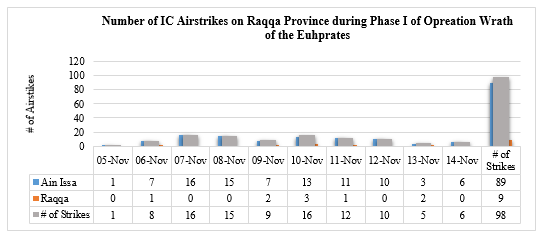
From its start, the operation focused on the rural areas south of Ain Issa, which are easy to take unlike residential areas. However, the situation was not so simple since ISIS depended on improvised explosive devices (IEDs), which were planted randomly around Ain Issa causing serious damage to the SDF. The presence of IEDs was the main reason for the heavy Coalition strike on areas where there were no ISIS forces present.
The second phase of Operation Wrath of the Euphrates started on December 10, 2016, aiming to take control of Raqqa’s western rural areas along the banks of the Euphrates River. The most significant development in this phase of the battle was the SDF’s announcement of new parties joining the operation:
- The Elite Forces of the Syrian Future Movement led by Ahmad Al Jarba after his deal with Movement for a Democratic Society (TEV-DEM).
- The Military Council of Deir Ezzor.
- Some Arab tribes from the area.
In the announcement came a confirmation by Jihan Sheikh Ahmed, a spokesperson for the Wrath of the Euphrates Operation, of successful coordination with the Coalition in the previous phase and the expectation of continued coordination.
The second phase of the operation lasted until January 16, 2017, during which 2,480 square kilometers were taken over from ISIS, as well as important places such as the historic Qalet Jaber.
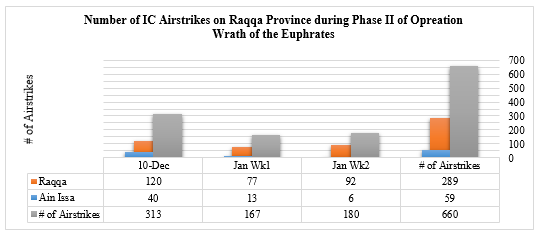
On February 4, 2017, the SDF announced the start of the third phase of Operation Euphrates Shield. This phase of the operation aimed to cut off lines of communication between Raqqa and Deir Ezzor and to make significant advances from the North and the West on ISIS’s self-declared capital.

In mid-March 2017, Coalition airstrikes intensified on Tabqa and the surrounding areas, reaching 125 strikes between March 17 and 26. On March 25, an offensive was launched to seize control of the 4 km-long Euphrates Dam in Tabqa. On March 26, the dam was struck by Coalition airstrikes making it non-operational.
Despite the heavy Coalition airstrikes, the YPG and its allies were unable to take the dam due to the large number of IEDs planted by ISIS. According to field interviews conducted by Omran Center, American troops landed in western rural Tabqa as YPG-led forces crossed the Euphrates River. An attack ensued on the Tabqa Military Airport from the South without striking the city itself.
On the evening of March 26, the YPG announced control over the military airport and immediately after—with oversight by American and French troops—the YPG started operations to take control of the rural parts of the city. By mid-April, the city was besieged and operations began to take the city with a significant uptick in Coalition airstrikes. Airstrikes on Tabqa city during the month of April 2017 reached 215 strikes, making Tabqa the most targeted city by the Coalition during that month, as shown below.
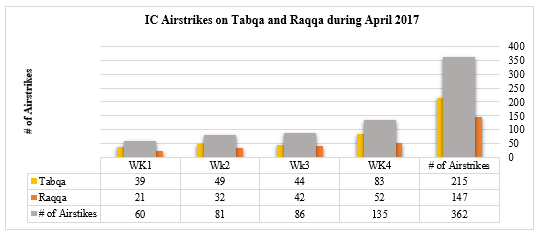
Forces involved in the Tabqa offensive: The Americans headed up the landing south of the Euphrates. French troops were present at Jabar on the other side of the river and were able to secure boat crossings for the YPG to the other side. Coalition forces wanted to take Tabqa Military Airport to make it a base for future operations and eventually for the complete siege of Tabqa. As for the YPG, its role was limited to protecting the backs of the Coalition forces and then moving in when the Coalition leaves.
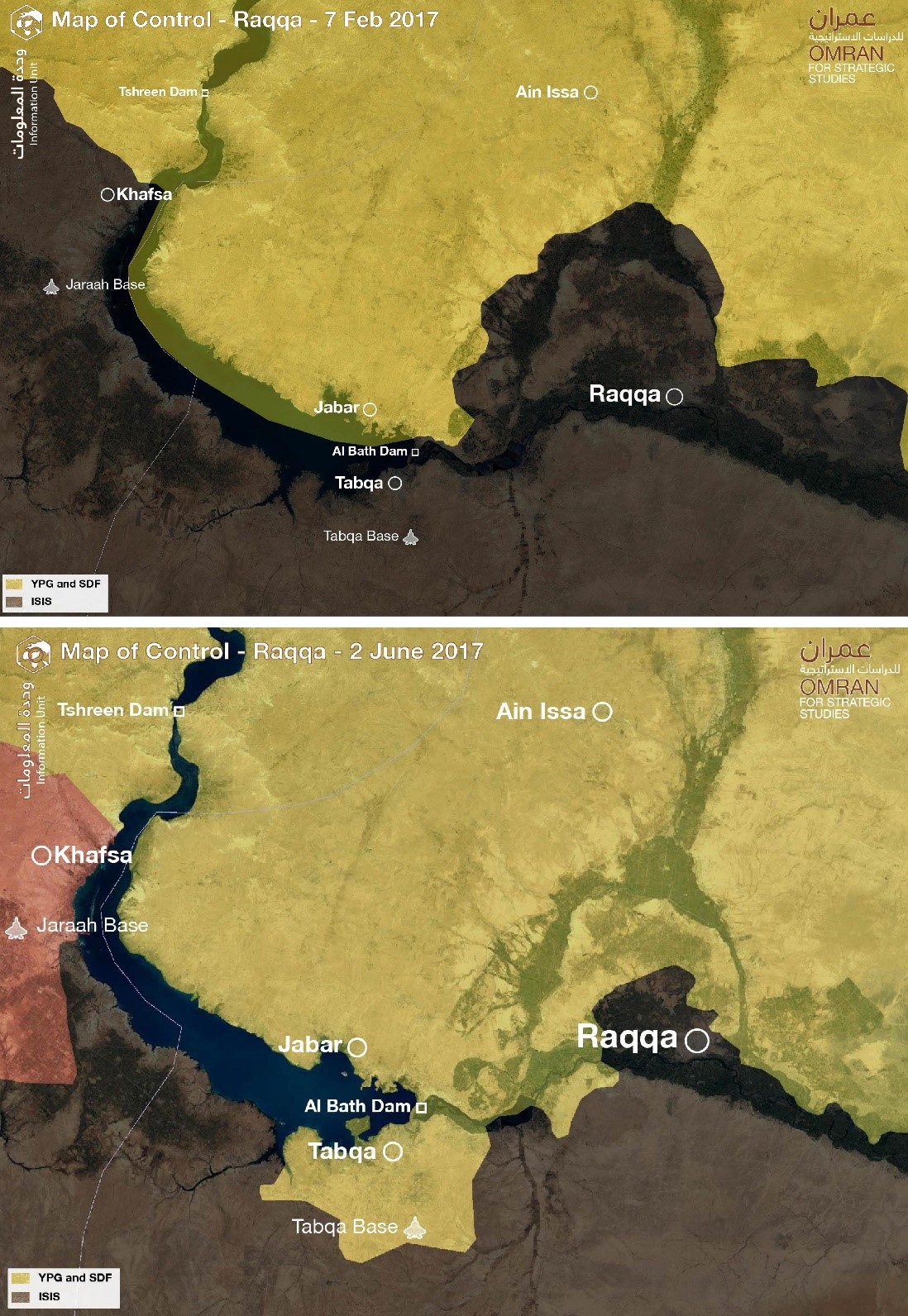
Map No. (1) Control and Influence of Raqqa and Tabqa, between 7 February 2017 and 2 June 2017
On April 13, the SDF announced the fourth phase of Operation Wrath of the Euphrates that aimed to take what remained of northern rural Raqqa and Jallab Valley, according to a statement released by the Wrath of the Euphrates operations room.([19])
Even though the SDF announced the fourth phase of Operation Wrath of the Euphrates, and previous phases achieved their stated goals, it was not able to take full control of Tabqa city until May 4, 2017. Furthermore, that only happened after making a deal with ISIS to let its fighters and their family members leave towards Deir Ezzor.([20])
Costs of the Battle (Infrastructure and Civilians):
Coalition strikes in September 2016 destroyed the remaining bridges that crossed the Euphrates River between the Iraqi border and eastern Raqqa. Additional raids destroyed the city's bridges on February 3, 2017. The Euphrates Dam was also damaged because of the clashes and now, with a damaged control room and the introduction of melting snow, the dam's status is questionable, with the water level increasing 10 meters since the beginning of the year.
The dam is now non-operational due to clashes between Kurdish fighters and ISIS, coupled with Coalition strikes. This has caused major concerns because if the dam breaks, the water could submerge more than one third of Syria and large parts of Iraq, reaching Ramadi.
Almost all of the hospitals in rural Raqqa are out of service. The only hospital remaining is operating at one fourth of its capacity even though there are approximately 200,000 civilians living there.([21])
On March 21, 2017, more than 200 civilians were killed and wounded in a Coalition strike on a school inhabited by displaced persons in the town of Mansoura in rural Raqqa.([22])
Again, on March 22, 2017, Coalition strikes committed another attack in Tabqa, west of Raqqa, targeting a bakery in a busy market killing at least 25 civilians and injuring more than 40 others.([23]) On April 22, 2017, another five civilians were killed and tens were injured in a Coalition airstrike on Tabqa.
In a mistaken strike by Coalition forces, 18 SDF fighters were killed south of Tabqa. The coalition released a statement explaining that the strike was conducted based on a request from one of its partners and the target was identified as an ISIS fighting position. The statement explained that the target was actually a front position of the SDF.([24])
Battle Scenarios
Even though the SDF is dominating the headlines and appears as the ideal force to liberate Raqqa, a number of factors indicate that there is more than one plausible scenario for the liberation of Raqqa. The issue is not determined solely by the force that will do the bulk of the fighting but also, who will administer the city after it is retaken, who will go after ISIS forces fleeing the city, and who will attack the last ISIS stronghold in Deir Ezzor, Syria.
The factors influencing the drawing up of possible battle scenarios are as follows:
- The SDF is unable to carry out the fight alone, evidenced by the need for direct participation from Coalition ground forces in critical positions and the increased number of American troops in Syria. Furthermore, the SDF has been ineffective in identifying enemy positions resulting in a large number of civilian deaths and even the deaths of 18 of its own fighters.
- Raqqa’s geographical positioning is quite difficult to deal with. It is open to Hassaka to the northeast and Deir Ezzor to the south, which is open to Iraq’s southeast. To the west, Raqqa is open to Hama and Homs, and to the north, Raqqa is open to Turkey. This requires a complicated coordination effort between local and international forces that must participate to make any final offensive effective.
- There is an ongoing struggle over ISIS’ legacy and the areas that it will leave behind that cover a significant geographic area. This issue is directly linked to the shaping of a political solution in Syria, which has put the battle of Raqqa under the pressures of conflicting interests of local, regional, and international actors involved in Syria.
- The Trump administration found itself in a predicament when it realized that the Obama administration’s Raqqa plan depended too heavily on arming and supporting Kurdish forces. On the contrary, the Trump administration adopted a policy of improving ties with Turkey and working closely with Russia to reach a political settlement to the Syrian crisis.
Given these factors, it is possible to project the following four scenarios for the battle of Raqqa:
First Scenario
The U.S. would continue to exclusively depend on the YPG and make serious attempts to take advantage of the Arab forces that are currently an inactive part of the SDF. This would balance out the influence of the PYD in the SDF. After Raqqa is liberated, it would be handed to a local council that represents the local population, as is being planned for now. This scenario seems more likely if we look at the increasing number of American troops in Syria. There are also 1,000 American Special Forces deployed in Kuwait on standby ready to be called in to support operations in Syria or Iraq. President Trump has also given the army the authority to determine appropriate troop levels in both Iraq and Syria.([25]) In this scenario, the U.S. would be able to conduct a successful operation to take Raqqa but with a significant footprint, including direct combat and an extended period. Moreover, the political issues would remain unresolved, especially with respect to Turkey. These unresolved political issues could heighten tensions between Turkey and the U.S. after the battle for Raqqa, especially since Turkey insists that the SDF refrain from taking control of any other territory and that current SDF-controlled territory be disconnected. Increased tensions with the U.S. may lead to a solution in this scenario that is something similar to what happened in Manbij.([26]) Moscow is hoping that it can take advantage of Turkish-American tensions in order to push the participation of regime forces as a legitimate option.
Second Scenario
The U.S. and Turkey would increase their coordination in Syria while pushing the PYD forces farther away. This would happen according to one of two Turkish plans. The first is that Turkish forces enter Syria towards Raqqa from Tal Abyad and the SDF opens a 25-km corridor for them. This would mean the PYD loses control of Tal Abyad and cuts off unobstructed access between Qamishli and Ain Arab (Kobani), which is unlikely. The other option is for Turkish forces to enter from Al Bab, which would mean either attacking regime forces or coordinating with them to secure a corridor access to Raqqa. It is unclear until now if the Trump administration is willing to completely give up its coordination with the SDF. In addition, the option of having Turkish-backed Arab forces fighting alongside the SDF is unlikely since both Turkey and the SDF reject such a proposal. Turkey will not participate in the battle if the other party includes PYD forces.
Third Scenario
The Americans and Russians would reach an agreement on the framework of a solution in Syria. This would include neutralizing Turkey and enabling the participation of regime forces alongside the YPG. This scenario would be welcomed by the regime. This scenario could become more likely because of the regime’s advances in eastern rural Aleppo reaching the administrative border of Raqqa Province (Ithraya-Khanaser). The regime has also reinforced its presence in Ithraya on the way to Tabqa, as well as in Palmyra, which is a critical position on the road between Palmyra and Raqqa. The regime has also been making attempts to increase its control of more positions in the desert by attacking “Usood al Sharqiyeh” forces in recent days.([27]) The regime also controls critical positions in Deir Ezzor, especially in the western rural areas congruent with Raqqa Province. This includes the Deir Ezzor Military Airport in the eastern part of the province, which extends to the Iraqi border. Thus, the regime puts the Coalition in a position where it has no choice but to coordinate with regime forces, either in the battle for Raqqa or in future operations.
Fourth Scenario
The results of the last Astana meeting to create four de-conflicted zones could be a premise for a fourth scenario in which the U.S. is more open to the participation of all interested parties from Astana in the battle for Raqqa and what comes after. This would include roles for the SDF, regime forces, and opposition forces backed by Turkey. American and Russian oversight would ensure effective implementation of the participating forces and prevent any infighting among them. The de-confliction zones proposal is the strongest evidence that such a scenario may be carried out. The de-confliction zones would essentially mean a truce between regime and opposition forces with well-defined borders in order for the parties to focus their efforts more closely on fighting ISIS. Turkey and Russia responded positively to the last Astana meeting, which followed a meeting between the presidents of Turkey and Russia, indicating that there are some preexisting agreements about Turkey’s participation in the battle for Raqqa. Furthermore, the American approval of the de-confliction zones indicates a possible three-way understanding about the battle for Raqqa. Another positive development is Russia’s reopening lines of communication with the U.S. regarding sharing and coordinating Syria’s air space. This was surprising given the deadly strikes on the Sheirat air base. Further clarification on this possible three-way understanding on the battle for Raqqa is expected following the meeting between U.S. President Donald Trump and Turkish President Recep Tayyip Erdogan in Washington, D.C. on [insert date].
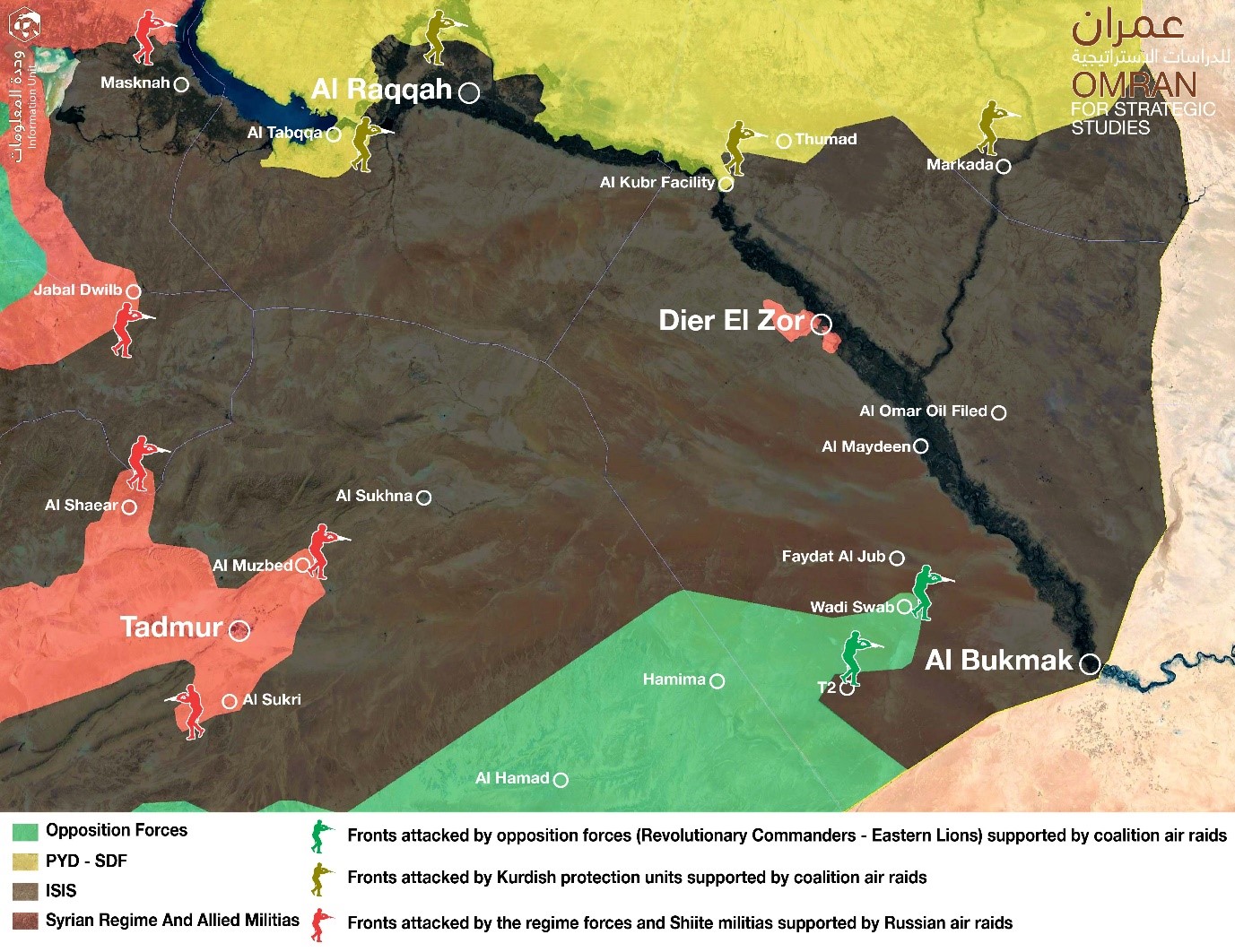
Map No. (2) Control and Influence of Eastern Syria – May 7, 2017
Conclusion
The presence of American forces in Syria joining the fight against ISIS is a significant change in the Syrian arena, making the situation more complicated and the interests of the various parties more contradictory. In the meantime, the U.S. continues to take advantage of these contradictory interests. Therefore, the most important contribution of the American entry into Syria was undermining the post-Aleppo status quo established by Russia in an attempt to create a new climate that is more consistent with an American policy that is more involved in the Middle East. These new understandings are still unclear and will not be completely understood until after the defeat of ISIS. The battle for Raqqa and what comes after are the apex of these understandings, especially the shape of a future Syria that regional and international actors will decide.
([1]) Front lines defenses were shored up at the eastern edge of Operation Euphrates Shield territory with regime, Russian, and US forces creating a buffer preventing any further Turkish backed offensive.
([3]) Fabrince Balance, The Battle for al-Bab Is Bringing U.S.-Turkish Tensions to a Head, The Washington Institute, 2017, https://goo.gl/Q5zGrg
([4]) Turkey announces the end of Operation Euphrates Shield, Arabic, Aljazeera Net, https://goo.gl/JvGtqT
([5]) “Eastern Shield Army”, A new formation to face three powers in Syria’s east, Enab Baladi News, Arabic, https://goo.gl/y4zVWx
([6]) Turkey’s plans to liberate Syria’s Raqqa, Turkey Now, Arabic, https://goo.gl/cmJr9X
([7]) American, Russian, Turkish coordination in Syria, Arabic, Aljazeera Net, https://goo.gl/O7cAC6
([8]) Moscow offers coordination with America in Syria, Al Hayat, https://goo.gl/mDCKb1
([9]) Front lines defenses were shored up at the eastern edge of Operation Euphrates Shield territory with regime, Russian, and US forces creating a buffer preventing any further Turkish backed offensive.
([10]) Safinaz Muhammad Ahmad, “Manbij and Raqqa..International and regional interventions and the new maps of influence in Syria”, Al Ahram for Strategic Studies, https://goo.gl/PyVtoS
([11]) Ibrahim Humeidi, Moscow’s surprise between Manbij and al Bab: Tempting Washington and marginalizing Ankara, Al Hayat, https://goo.gl/VnGkKn
([12]) Larijani: US intervention in Syria is not in its favor .. The presence of the Marines was not in coordination with Tehran .. We do not aim to achieve special interests in Syria, Rai Al Youm, https://goo.gl/PRk0SA
([15]) "Marines" in Syria to accelerate the battle of Raqqa ... and "reassure" Turkey, Al Hayat, https://goo.gl/UELPQg
([17]) PKK is the Kurdistan Workers Party
([18]) After abandoning Obama's plan .. Trump is looking for his way to Raqqa, Russia Today Arabic, https://goo.gl/jvyX8p
([19]) The fourth phase of “Wrath of the Euphrates”: Trying to reach Raqqa’s border, The New Arab, https://goo.gl/JTHxLS
([20]) Daesh withdraws from Tabqa under agreement with SDF, The New Arab, https://goo.gl/3cZcD3
([21]) Raqqa, Between Coalition massacres and preparing for what is after Daesh, Enab Baladi, https://goo.gl/OiQTJ0
([22]) A new massacre by the international coalition in Mansoura in rural Raqqa, Zaman Alwasl, https://goo.gl/6VUbGZ
([23]) The international coalition commits a massacre in Tabqa, Raqqa Post, https://goo.gl/pp2wLv
([25]) Trump gives the Pentagon the power to determine troop levels in Iraq and Syria, Reuters, https://goo.gl/7Er9oO
([26]) Front lines defenses were shored up at the eastern edge of Operation Euphrates Shield territory with regime, Russian, and US forces creating a buffer preventing any further Turkish backed offensive.
([27]) Lions of the East: The regime advances in rural eastern Sweida, MicroSyria, https://goo.gl/zB8cIV

